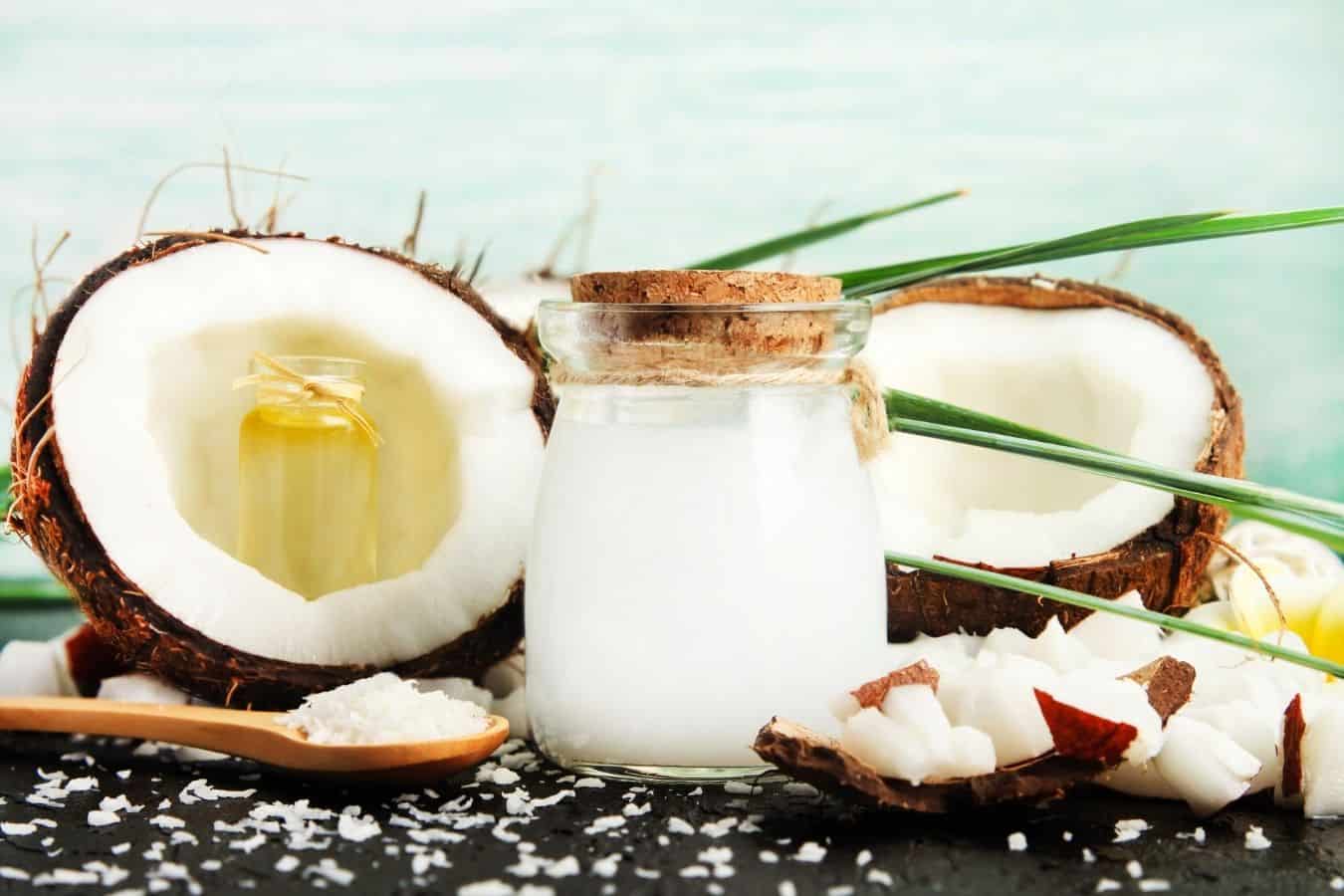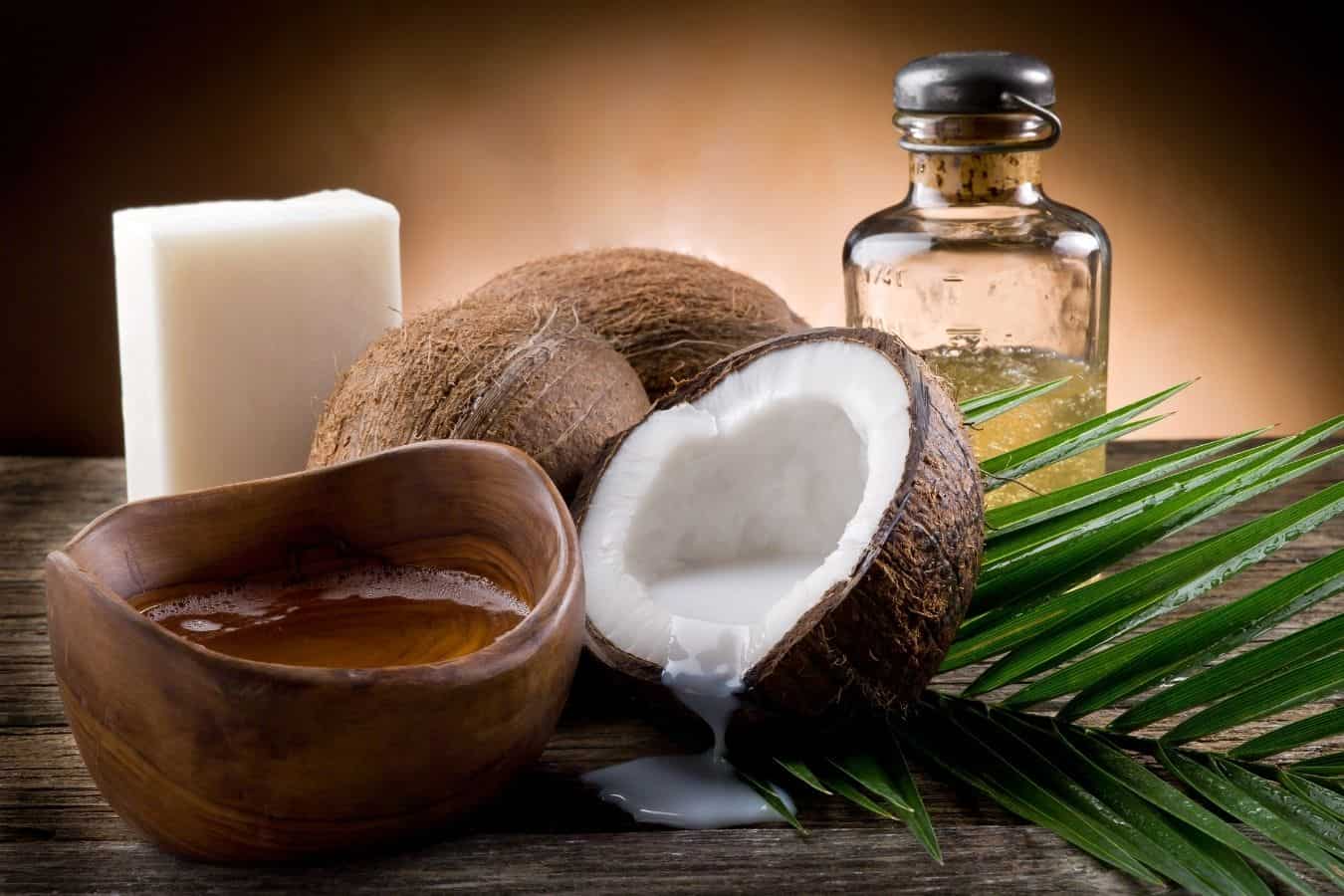In recent years, coconut oil has had a surge in popularity due to its reported health benefits. But it is also enjoying a popularity boom in the hair and beauty industry. In this article, we will look at the benefits of coconut oil and, in particular, the advantages of using coconut oil on your hair before bleaching.

Before bleaching your hair, it is recommended that you use coconut oil. Bleaching involves the application of a cocktail of chemicals to your hair which can leave hair fragile and more susceptible to damage and loss. The nutrients in coconut oil will give your hair a layer of protection from this harsh process and reduce the potential damage to your hair.
Why Is Coconut Oil Good For Hair?
Coconut oil is bursting with vitamins and fatty acids which add nourishment to the scalp and penetrate the cuticles of the hair.
Using coconut oil in your hair results in a reduction in protein loss which keeps hair looking healthy.
This is why it is a great ingredient to use as a pre-poo treatment for hair coloring or even before straightening your hair.
It is also reported to boost hair growth, reduce hair breakage, protect hair from sun damage and effectively combat dandruff.
Leo Izquierdo, the co-founder of IGK haircare, says coconut oil is different from other oils for hair as it can deeply penetrate the hair in order to impart its healthful properties.
Why Should I Use Coconut Oil Before Bleaching?
When bleach is added to your hair, a chemical reaction takes place. The bleach reacts with the melanin in the hair, and this removes the color.
In removing the color, the bleach breaks apart the hair’s proteins (these are what keep your hair strong). The melanin is still there but the molecule has been oxidized and is colorless.
Bleach contains a lightening agent and hydrogen peroxide tends to be the most common. The chemistry involved in all of this results in changes in the pH level of your hair.
This opens up the hair shaft, which allows the peroxide to react with the melanin.
Giving yourself a treatment with coconut oil prior to bleaching offers your hair a level of protection against the bleach. According to research published in the Journal of Cosmetic Science, prior use of coconut oil significantly reduces the amount of protein lost during the bleaching process.
Also Read: How to Tame Frizzy Hair Overnight (5 Easy Hacks)
How Coconut Oil Helps With The Bleaching Process
The molecules of coconut oil are tiny which means they can penetrate the hair easier than many other oils.
Coconut oil adds nourishment to the hair and scalp from the inside out. It works by filling up the hair shafts which have been hollowed out by the bleaching process.
This results in hair that is thick and lustrous. It also protects the hair from additional damage.
Furthermore, it helps to trap protein in the hair by closing the hair follicles which have been opened by the lightning agent in the bleach.
Using coconut oil before bleaching is also reported to relieve the burning and itching sensation that can often accompany the process of bleaching.
How To Use Coconut Oil For Hair Before Bleaching

The key factor in using coconut oil in your hair before bleaching is just that. Make sure you do add it before the bleaching process. It is also beneficial to apply it to the hair after the bleaching process is complete, as part of the aftercare. However, this will only be effective if you have also used it prior to bleaching.
Instructions:
Step 1: Melt the coconut oil
Typically, coconut oil is available in a solid form so you will need to melt this solid. Either scoop some into your hands and warm between your palms. Or put some into a bowl and gently warm in the microwave, being careful not to overheat it.
Step 2: Section your hair
Split your hair into three equal sections. If your hair is thicker you may need to split it into more sections. Apply the coconut oil from root to tip, making sure it coats all strands of your hair.
Step 3: Massage
Release the layers and massage the coconut oil thoroughly through the hair and into the scalp. Use a comb to ensure the oil is getting into all sections of the hair.
Step 4: Use a shower cap
Pop on a shower cap. Leave the coconut oil to hydrate and nourish your hair for a few hours or overnight if you can manage it. The shower cap will keep your pillowcases clean.
Step 5: Bleach
Do not wash out the coconut oil at this stage. You can choose to let your hair dry or leave your hair wet. Do note that if you choose to bleach your hair damp, the bleach won’t be as effective. This may be suitable if you’re worried about too big of a change but also note that hair is more sensitive when wet.
Take precautions and follow instructions on the box.
Step 6: Rinse
Give your bleaching powder the instructed time then wash everything out. You may have to rinse more vigorously than normal to ensure you get all the coconut oil out.
Should I Rinse Out The Coconut Oil?
Some sources believe that if you want your hair to be lightened sufficiently then you need to rinse the coconut oil out of your hair before application of the bleac
If you’re worried about the bleach not having enough of an effect, you can follow the method above. Then rinse your hair with a clarifying shampoo. Massage it thoroughly into your hair then rinse out.
If your hair still feels oily and greasy, shampoo again and rinse. But try not to overdo the shampooing as this can have an impact on the protective ‘shield’ of the coconut oil.
Then proceed with the bleaching process.
Also Read: [Answered] Is Coconut Oil Good For Low Porosity Hair?
How Long To Leave Coconut Oil In Hair Before Bleaching
There are several opinions on how long to leave coconut oil in your hair before bleaching.
Coconut oil should be left to penetrate the hair for a minimum of one hour. If you can manage two hours, even better.
Leaving the coconut oil to work in your hair overnight is another option. Just pop a shower cap on to save your bedding. Allowing the coconut oil to stay on your hair for this length of time will not do any damage to your hair as coconut oil is a natural organic product full of goodness.
In order to protect your precious hair, this is a step that really should not be skipped and your locks will thank you for it. The bleach will still be able to get through the coconut oil to lighten your hair. It just means that your hair won’t be so fragile or prone to damage afterwards.
Fine Hair v Thick Hair
Another factor to consider when thinking about how long to leave coconut oil in your hair before bleaching is the thickness of your hair.
If you have fine hair, you may want to leave the coconut oil in for a few hours. Whereas if your hair is on the thicker side, you may prefer to leave it in for longer before bleaching, or indeed, overnight.
How To Take Care Of Bleached Hair
It is important to commit to the aftercare process in order to reduce the damage caused by the aggressive process of hair bleaching.
Here’s a few things to keep in mind:
Oils Are Good
Coconut oil, olive oil, argan oil and almond oil are all sources of replenishment for your hair after it has been bleached.
- Coconut oil seals the hair and works to prevent the loss of protein. This can be massaged into the strands and left for a few hours or overnight.
- Olive oil is effective in hydrating and nourishing the hair. Use a few drops on your fingertips and rub into the ends of the hair.
- Argan oil is packed with antioxidants which can reduce further damage to the hair. Add a few drops after styling to replenish lost moisture.
- Almond oil is rich in proteins and Vitamin E which strengthens the hair strands. A few drops of this can be applied every day, or it can be used as part of a deep conditioning hair mask.
Alternatively, if you have low porosity hair, shea butter may be the better choice. This is due to the moisturizing properties of shea butter which is able to penetrate the hair cuticles better than coconut oil.
Deep Condition Your Hair
Invest in a deep conditioner to replenish your overwrought hair strands. Deep conditioners are packed with ingredients that get deep into the hair to really nourish the cuticles and restore those broken bonds in your hair
Be Gentle
Bleaching your hair means the natural oils are stripped out from the hair follicles.
To give your hair follicles time to heal, reduce how often you wash your hair. For the first week after the hair has been bleached, perhaps think about not using any shampoo at all, just conditioner.
After that, try to use a sulfate-free shampoo as this is kinder on bleached hair which has endured such a chemical process. It is also a good idea to use a shampoo that is hydrating as this will clean your hair without reducing its natural oils.
Avoid Heat Styling
After bleaching your hair is especially susceptible to heat styling damage so try to cut back on hairdryers, straightening irons and curling irons for the first few weeks after the process.
After that continue to keep the use of heat styling to a minimum to give your hair a chance to repair and thrive.
Be Careful Of Chlorine
If your hair is already fragile from bleaching, introducing chlorine can exacerbate the issue. It can also mess with the color, giving hair a brassy hue, or an orange or green tint.
To try to combat this, rinse your hair in cool water before and after you come in to contact with any chlorinated water. You could also try covering your hair with a swim cap.
Comb Hair When Wet
Bleached hair is more prone to becoming tangled. To avoid this scenario, use a wide -toothed comb or a wet brush with flexible bristles.
So, to round up, using coconut oil in your hair before and after can help to protect it from the damage caused by the harshness of the bleaching process. It will help rebuild the broken bonds, leaving your hair full of vitality and well nourished.
Disclaimer: This site is not intended to provide professional or medical advice. All of the content on LovedByCurls.com is for informational purposes only. All advice should be followed at your own discretion. Ingredients may change at any time so always check the product label before using. Check our full disclaimer policy here.
